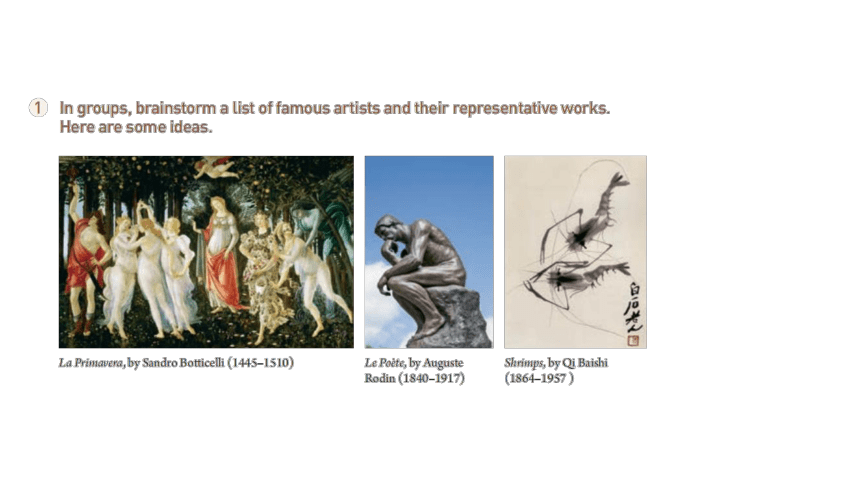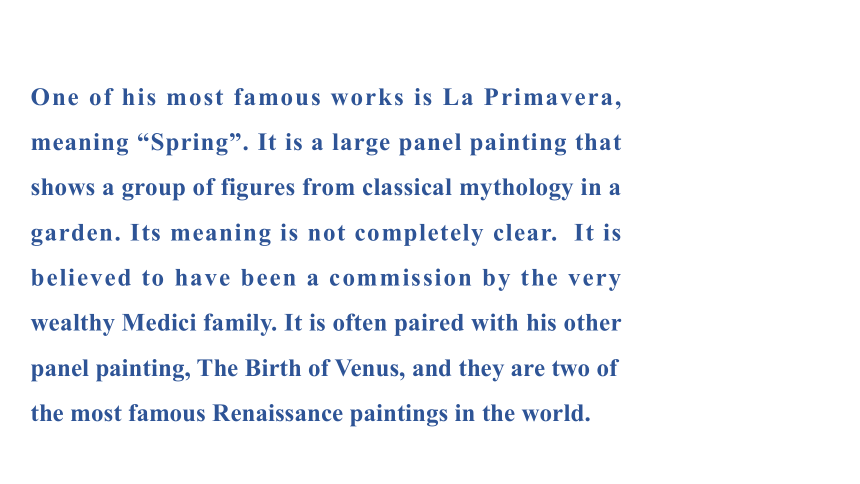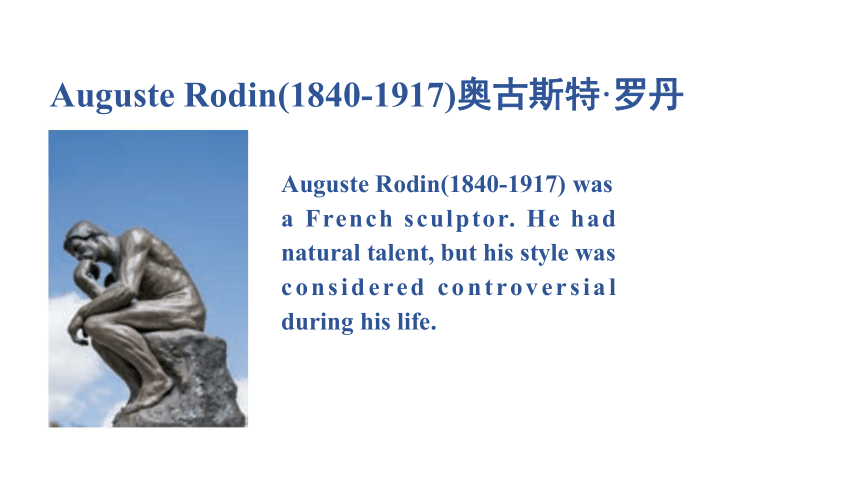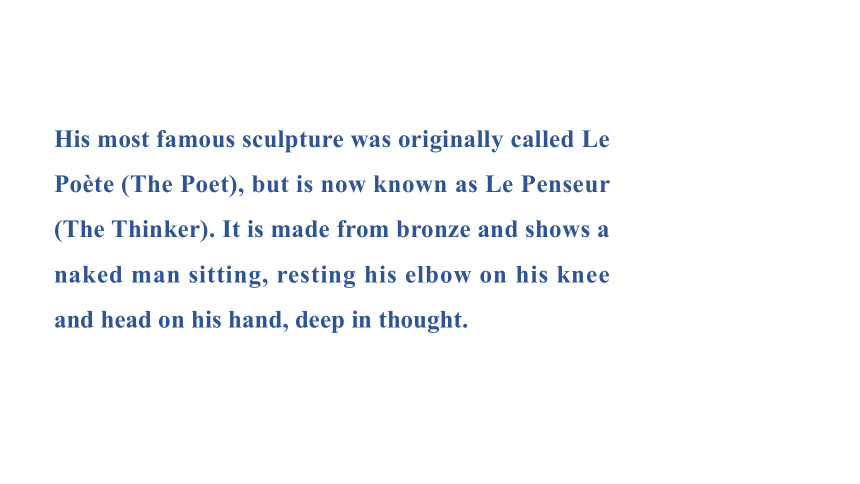Unit 1 Art Project 课件(13张PPT)
文档属性
| 名称 | Unit 1 Art Project 课件(13张PPT) |

|
|
| 格式 | pptx | ||
| 文件大小 | 1.0MB | ||
| 资源类型 | 试卷 | ||
| 版本资源 | 人教版(2019) | ||
| 科目 | 英语 | ||
| 更新时间 | 2024-04-29 15:27:08 | ||
图片预览






文档简介
(共13张PPT)
Unit 1 Project
Sandro Botticelli(1445-1510) was an Italian Renaissance painter. He belonged to the Florentine/'fl r nta n/ school and painted a wide range of religious and mythological subjects as well as portraits.
Sandro Botticelli(1445-1510) 桑德罗·波提切利
One of his most famous works is La Primavera, meaning “Spring”. It is a large panel painting that shows a group of figures from classical mythology in a garden. Its meaning is not completely clear. It is believed to have been a commission by the very wealthy Medici family. It is often paired with his other panel painting, The Birth of Venus, and they are two of the most famous Renaissance paintings in the world.
Auguste Rodin(1840-1917) was a French sculptor. He had natural talent, but his style was considered controversial during his life.
Auguste Rodin(1840-1917)奥古斯特·罗丹
His most famous sculpture was originally called Le Poète (The Poet), but is now known as Le Penseur (The Thinker). It is made from bronze and shows a naked man sitting, resting his elbow on his knee and head on his hand, deep in thought.
Qi Baishi(1864-1957) is an influential Chinese painter from Anhui Province.He worked as a carpenter in his early years and gradually became a Chinese painting master through hard work. He was well known in painting shrimps in a concise and vivid way.
Qi Baishi(1864-1957)
In Chinese art history, Qi Baishi ranks as a towering figure. His playful style opened up a new vista in the imagery of traditional Chinese painting, and has left a rich legacy still widely recognized in modern society.
Shrimps have been a favorite subject of Qi Baishi's artwork for decades. He could render them so vividly that they seem to swim off the canvas. The sight of the shrimps can immerse people in a watery world.
H: Talk Show Host A: Artist (Salvador Dali)
M:Artisfs mother F: Artisfs friend
T: Artisfs teacher C: Art critic
H: Today I am very honoured to welcome the Spanish surrealist artist Salvador Dali to our studio. First, tell us a little about your life and how you first became an artist.
A: At the age of six I wanted to be a cook. At seven I wanted to be Napoleon. And my ambition has been growing steadily ever since. I love art, but painting is really a small part of who I am.
H: Interesting. Confidence is an important quality for an artist! What is your philosophy towards art, and which do you think are your most representative works
A: One should strive for perfection but accept
one will never reach it. As for Surrealism, it is destructive, but it destroys only what it considers to be shackles limiting our vision. A key work of mine is The Persistence of Memory. In it, I challenge the idea that time is a hard and unchanging thing, symbolised by what some people call my "melting watches".
H: Fascinating. Welcome also to your mother, Felipa. What was Salvador like growing up
M: He showed a keen interest in art and artistic talent from a young age, so I always tried to encourage him to pursue art.
H: This is Man Ray, a fellow surrealist artist and long-time friend of Dali. How did you first meet Salvador What is he like as a friend
F: We first met in Paris with other surrealist
artists. He is a loyal friend and very committed to his art. He always gets everyone's attention because he is eccentric in what he wears and does. He is fun to be arround.
H: Finally, we welcome the respected art critic and author, Luis Romero. How is Dali's work received critically
C: Although his work is often controversial, behind the outrageous images, there is great artistic skill. He is clearly influenced by Renaissance art styles.
H: Well, thank you all for your time today, and special thanks to Dali for your amazing body of work that has inspired and brought wonder to so many people over the years.
THANK YOU
Unit 1 Project
Sandro Botticelli(1445-1510) was an Italian Renaissance painter. He belonged to the Florentine/'fl r nta n/ school and painted a wide range of religious and mythological subjects as well as portraits.
Sandro Botticelli(1445-1510) 桑德罗·波提切利
One of his most famous works is La Primavera, meaning “Spring”. It is a large panel painting that shows a group of figures from classical mythology in a garden. Its meaning is not completely clear. It is believed to have been a commission by the very wealthy Medici family. It is often paired with his other panel painting, The Birth of Venus, and they are two of the most famous Renaissance paintings in the world.
Auguste Rodin(1840-1917) was a French sculptor. He had natural talent, but his style was considered controversial during his life.
Auguste Rodin(1840-1917)奥古斯特·罗丹
His most famous sculpture was originally called Le Poète (The Poet), but is now known as Le Penseur (The Thinker). It is made from bronze and shows a naked man sitting, resting his elbow on his knee and head on his hand, deep in thought.
Qi Baishi(1864-1957) is an influential Chinese painter from Anhui Province.He worked as a carpenter in his early years and gradually became a Chinese painting master through hard work. He was well known in painting shrimps in a concise and vivid way.
Qi Baishi(1864-1957)
In Chinese art history, Qi Baishi ranks as a towering figure. His playful style opened up a new vista in the imagery of traditional Chinese painting, and has left a rich legacy still widely recognized in modern society.
Shrimps have been a favorite subject of Qi Baishi's artwork for decades. He could render them so vividly that they seem to swim off the canvas. The sight of the shrimps can immerse people in a watery world.
H: Talk Show Host A: Artist (Salvador Dali)
M:Artisfs mother F: Artisfs friend
T: Artisfs teacher C: Art critic
H: Today I am very honoured to welcome the Spanish surrealist artist Salvador Dali to our studio. First, tell us a little about your life and how you first became an artist.
A: At the age of six I wanted to be a cook. At seven I wanted to be Napoleon. And my ambition has been growing steadily ever since. I love art, but painting is really a small part of who I am.
H: Interesting. Confidence is an important quality for an artist! What is your philosophy towards art, and which do you think are your most representative works
A: One should strive for perfection but accept
one will never reach it. As for Surrealism, it is destructive, but it destroys only what it considers to be shackles limiting our vision. A key work of mine is The Persistence of Memory. In it, I challenge the idea that time is a hard and unchanging thing, symbolised by what some people call my "melting watches".
H: Fascinating. Welcome also to your mother, Felipa. What was Salvador like growing up
M: He showed a keen interest in art and artistic talent from a young age, so I always tried to encourage him to pursue art.
H: This is Man Ray, a fellow surrealist artist and long-time friend of Dali. How did you first meet Salvador What is he like as a friend
F: We first met in Paris with other surrealist
artists. He is a loyal friend and very committed to his art. He always gets everyone's attention because he is eccentric in what he wears and does. He is fun to be arround.
H: Finally, we welcome the respected art critic and author, Luis Romero. How is Dali's work received critically
C: Although his work is often controversial, behind the outrageous images, there is great artistic skill. He is clearly influenced by Renaissance art styles.
H: Well, thank you all for your time today, and special thanks to Dali for your amazing body of work that has inspired and brought wonder to so many people over the years.
THANK YOU
